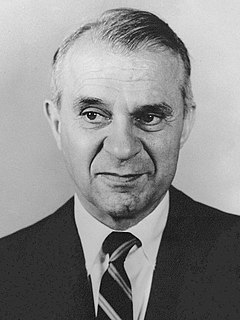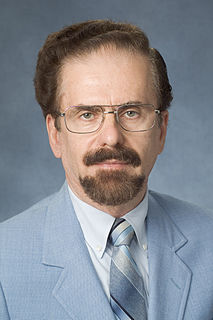Alan W. Heston (born 1934 in Portland, Oregon) is an American economist best known for his collaborative work with fellow economist Robert Summers and the development of the Penn World Table (PWT). [1]
Heston was born October 18, 1934, and raised in Portland, Oregon. In 1955, he received his B.A. in economics from the University of Oregon. He received his M.A. in economics from the University of Washington in 1957. In 1962, he received his Ph.D. in economics from Yale University, where he studied under James Tobin, the winner of the 1981 Nobel Memorial Prize in Economic Sciences.
Heston is a professor emeritus in the Department of Economics at the University of Pennsylvania, where he has taught since 1962. Prior to teaching at the University of Pennsylvania, Heston was an assistant professor at Yale University.
Heston co-directs (with Robert Summers) the University of Pennsylvania's Center for International Comparisons (CIC). The precursor to CIC was the United Nations’ (UN) International Comparison Programme (ICP), which Heston joined in its first year in 1968. The ICP developed the first systematic multilateral set of purchasing power comparisons. Heston participated in the ICP's benchmark comparisons and, by 1985, with Summers and Irving Kravis, expanded the number of countries included in the comparison database to 34 countries. That same year Heston and Summers developed benchmark comparisons of gross domestic product estimates on a purchasing power basis for non-benchmark countries for one year. Heston and Summers continued these comparisons and extended the estimates over both time and space in an effort that became the Penn World Table. [2] For that work, Summers and Alan Heston were recognized as American Economic Association Distinguished Fellows in 1998. Heston is considered a leading world expert on international economic comparisons and purchasing power parity. [3]
In 1991, Heston co-authored with Summers a Quarterly Journal of Economics article titled "The Penn World Table (Mark 5): An Expanded Set of International Comparisons." [4] This article describes the Penn World Table as a set of national-accounts economic time series covering 138 countries. [5] Penn World Table expenditure entries are denominated in a common set of prices in a common currency to enable real quantity comparisons between countries and over time. The table also provides relative price details within and between countries, demographic data, and capital stock estimates. The article introduced an updated, revised, and expanded version of the table with broader applicability to researchers, and was one of the most cited economic papers of the 1990s. [6] Heston's and Summers’ techniques and data are widely used and cited, and a number of international organizations have adopted their methodology. [7]
In developing the Penn World Table, Heston, with Kravis and Summers, produced a series of three publications in 1975, 1978, and 1982. [8] These publications provided the detailed methodology of their international measurement approach to multilateral comparisons. The three economists developed an international price index for the valuation of each country's quantities. These formulas came into the limelight as the re-structuring and assistance programs of the major multilateral investment institutions gained traction in the 1980s and required more refined data for loan and assistance programs. [9]
An economist is a professional and practitioner in the social science discipline of economics.

Free trade is a trade policy that does not restrict imports or exports. It can also be understood as the free market idea applied to international trade. In government, free trade is predominantly advocated by political parties that hold economic liberal positions, while economic nationalist and left-wing political parties generally support protectionism, the opposite of free trade.
Purchasing power parity (PPP) is the measurement of prices in different countries that uses the prices of specific goods to compare the absolute purchasing power of the countries' currencies. In many cases PPP produces an inflation rate equal to the price of the basket of goods at one location divided by the price of the basket of goods at a different location. The PPP inflation and exchange rate may differ from the market exchange rate because of poverty, tariffs, and other transaction costs.

Wassily Wassilyevich Leontief, was a Soviet-American economist known for his research on input–output analysis and how changes in one economic sector may affect other sectors.
The Balassa–Samuelson effect, also known as Harrod–Balassa–Samuelson effect, the Ricardo–Viner–Harrod–Balassa–Samuelson–Penn–Bhagwati effect, or productivity biased purchasing power parity (PPP) is the tendency for consumer prices to be systematically higher in more developed countries than in less developed countries. This observation about the systematic differences in consumer prices is called the "Penn effect". The Balassa–Samuelson hypothesis is the proposition that this can be explained by the greater variation in productivity between developed and less developed countries in the traded goods' sectors which in turn affects wages and prices in the non-tradable goods sectors.
The Penn effect is the economic finding that real income ratios between high and low income countries are systematically exaggerated by gross domestic product (GDP) conversion at market exchange rates. It is associated with what became the Penn World Table, and it has been a consistent econometric result since at least the 1950s.

The American Economic Association (AEA) is a learned society in the field of economics. It publishes several peer-reviewed journals acknowledged in business and academia. There are some 23,000 members.

The System of National Accounts is an international standard system of national accounts, the first international standard being published in 1953. Handbooks have been released for the 1968 revision, the 1993 revision, and the 2008 revision. The System of National Accounts, in its various released versions, frequently with significant local adaptations, has been adopted by many nations. It continues to evolve and is maintained by the United Nations, the International Monetary Fund, the World Bank, the Organisation for Economic Co-operation and Development and the Statistical Office of the European Communities

William Arnold Barnett is an American economist, whose current work is in the fields of chaos, bifurcation, and nonlinear dynamics in socioeconomic contexts, econometric modeling of consumption and production, and the study of the aggregation problem and the challenges of measurement in economics.
Robert Summers was an economist and professor at the University of Pennsylvania, where he taught from 1960. A widely cited early work by Summers is on the small-sample statistical properties of alternate regression estimators where analytical measures are unavailable.
The international dollar, also known as Geary–Khamis dollar, is a hypothetical unit of currency that has the same purchasing power parity that the U.S. dollar had in the United States at a given point in time. It is mainly used in economics and financial statistics for various purposes, most notably to determine and compare the purchasing power parity and gross domestic product of various countries and markets. The year 1990 or 2000 is often used as a benchmark year for comparisons that run through time. The unit is often abbreviated, e.g. 2000 US dollars or 2000 International$.

Anne Osborn Krueger is an American economist. She was the World Bank Chief Economist from 1982 to 1986, and the first deputy managing director of the International Monetary Fund (IMF) from 2001 to 2006. She is currently the senior research professor of international economics at the Johns Hopkins School of Advanced International Studies in Washington, D.C. She also is a senior fellow of Center for International Development and the Herald L. and Caroline Ritch Emeritus Professor of Sciences and Humanities' Economics Department at Stanford University.
Michael Ward was a British economist and statistician who contributed significantly to the evolution of the international statistical system in the post-war period.
The Penn World Table (PWT) is a set of national-accounts data developed and maintained by scholars at the University of California, Davis and the Groningen Growth Development Centre of the University of Groningen to measure real GDP across countries and over time. Successive updates have added countries, years (1950-2017), and data on capital, productivity, employment and population. The current version of the database, version 9, thus allows for comparisons of relative GDP per capita, as a measure of standard of living, the productive capacity of economies and their productivity level. Compared to other databases, such as the World Bank's World Development Indicators, the time period covered is larger and there is more data that is useful for comparing productivity across countries and over time.

The Center on International Cooperation (CIC) is a foreign policy think tank based at New York University that works to enhance multilateral responses to global problems, including: conflict, humanitarian crises, and recovery; international security challenges, including weapons proliferation and the changing balance of power.; and resource scarcity and climate change.
Milton Gilbert was an economist and finance expert who worked at the United States Department of Commerce, Organisation for European Economic Cooperation (OEEC) and Bank for International Settlements.
Irving B. Kravis was an American economist famous for his work on international price comparisons, leading to the first version of the Penn World Table.
Robert Christopher Feenstra is an American economist, academic and author. He is the C. Bryan Cameron Distinguished Chair in International Economics at University of California, Davis. He served as the director of the International Trade and Investment Program at the National Bureau of Economic Research from 1992 to 2016. He also served as Associate Dean in the Social Sciences at the University of California, Davis from 2014 to 2019.